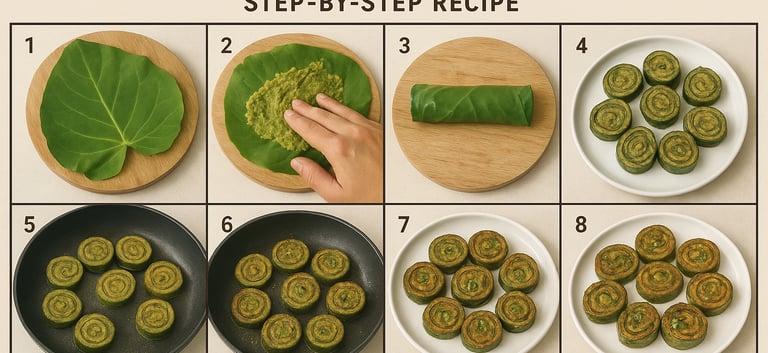Patra Recipe
History and cultural significance Ancient Roots: The colocasia plant, native to South India, has been cultivated in the region for millennia, with a history dating back to at least 2000 BCE. This long-standing availability made it a foundational ingredient for developing inventive, plant-based dishes. Early Preservation Method: The origins of patra lie in the ingenuity of cooks who sought to create a flavorful dish that also had a long shelf life. Steaming and tempering the rolled leaves allowed the food to be stored and enjoyed over a longer period. Regional Variations: While patra is a Gujarati staple, similar dishes exist across India. In Maharashtra, it is known as alu vadi, and in the Konkan region, a variant called patrode uses a paste of rice, lentils, and coconut. The specific spices and batters vary regionally. Cultural Tradition: Beyond just a dish, patra is considered a cherished tradition in Gujarati culture, often passed down through generations within families. It is frequently served as an appetizer or communal snack during festivals and family gatherings. The act of preparing and sharing patra symbolizes togetherness and celebration.
Sneha Parikh
10/7/20252 min read


Patra Recipe (Gujarati Alu Vadi)
A delicious Gujarati snack made from colocasia (arbi) leaves coated with a spiced gram flour (besan) paste, then rolled, steamed, sliced, and tempered.
Ingredients
For the Batter
1 cup gram flour (besan)
1½ tbsp tamarind pulp (imli)
1 tbsp jaggery (gud), grated
½ tsp turmeric powder (haldi)
1½ tsp red chilli powder
1 tsp coriander powder (dhaniya)
½ tsp cumin powder (jeera)
½ tsp garam masala
Salt to taste
Water (as needed to make a thick paste)
For Rolling
8–10 colocasia leaves (arbi or taro leaves), large and fresh
(Remove thick veins from the back and flatten lightly with a rolling pin)
For Tempering
2 tbsp oil
½ tsp mustard seeds (rai)
½ tsp sesame seeds (til)
A pinch of asafoetida (hing)
Curry leaves (kadi patta), a few
Chopped coriander for garnish
Fresh grated coconut (optional)
Method
Step 1: Prepare the Batter
In a bowl, mix besan, tamarind pulp, jaggery, salt, turmeric, and other spices.
Add a little water at a time to form a thick, smooth, spreadable paste.
Taste — it should be tangy, spicy, and slightly sweet.
Step 2: Prepare the Leaves
Wash and pat dry colocasia leaves.
Place one leaf vein side up and spread the batter evenly.
Place another leaf on top and repeat — use 3–4 leaves for each roll.
Roll the layered leaves tightly from the bottom, folding in sides.
Steam the rolls for 20–25 minutes or until firm. Let them cool completely.
Step 3: Slice and Temper
Once cooled, cut the rolls into ½-inch thick slices.
Heat oil in a pan, add mustard seeds, sesame seeds, hing, and curry leaves.
Add the patra slices and sauté until golden and slightly crispy on both sides.
Step 4: Garnish and Serve
Sprinkle fresh coriander and grated coconut.
Serve hot with green chutney or sweet tamarind chutney.
Quick Tips
If the leaves are large, use 3 per roll; if small, layer 4–5.
Always cool before slicing — it prevents breaking.
You can air fry or shallow fry for a crispier version.
Adjust tamarind–jaggery ratio as per your taste.
Patra (also known as Alu Vadi) is moderately low in calories and quite nutritious — rich in fiber, protein (from besan), and iron (from colocasia leaves).
Here’s an approximate breakdown
Calories in Patra (per serving)
Quantity
Approx. Calories
1 piece (medium slice)
35–40 kcal
4–5 pieces (1 serving plate)
150–200 kcal
100 grams
~180 kcal
